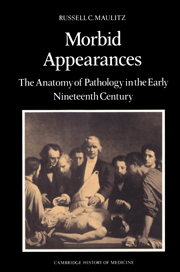Book contents
- Frontmatter
- Contents
- Dedication
- Preface
- Introduction: Ouverture: Bichat's head
- PART ONE PARIS
- PART TWO CHANNEL CROSSING
- PART THREE LONDON
- 7 After Waterloo: Medical journalism and the surgeon-apothecaries
- 8 Pathology and the specialist: The London Academy of Minute Anatomy
- 9 Propagation
- Conclusion: A language of morbid appearances
- Appendix: Transcription and translation of Figure 1.1
- Notes
- Selected bibliography
- Index
9 - Propagation
Published online by Cambridge University Press: 22 September 2009
- Frontmatter
- Contents
- Dedication
- Preface
- Introduction: Ouverture: Bichat's head
- PART ONE PARIS
- PART TWO CHANNEL CROSSING
- PART THREE LONDON
- 7 After Waterloo: Medical journalism and the surgeon-apothecaries
- 8 Pathology and the specialist: The London Academy of Minute Anatomy
- 9 Propagation
- Conclusion: A language of morbid appearances
- Appendix: Transcription and translation of Figure 1.1
- Notes
- Selected bibliography
- Index
Summary
Crummles: “Invention! What the devil's that got to do with it!
Nicholas: “Everything, my dear sir.”
Crummles: “Nothing, my dear sir. Do you understand French?”
Nicholas: “Perfectly well.”
Crummles: “Very good,” opening the table-drawer and giving a roll of paper to Nicholas. “There, just turn that into English, and put your name on the title-page. Damn me, if I haven't often said that I wouldn't have a man or woman in my company what wasn't master of the language, so that they might learn it from the original, and play it in English, and by that means save all this trouble and expense.”
– Charles Dickens, The Life and Adventures of Nicholas Nickleby (1839)In the 1820s and 1830s the heart of power in medical London still lay in the alliance of laymen and medicosurgical elites. The power to act as arbiters of medical truth and its clinical use in correct social circles continued to reside in large measure in the hands of those who held key posts. To physicians and surgeons the Royal Colleges' ruling councils and the major hospital teaching posts offered such access to power. Behind them, conferring patronage, sat the lay hospital governors and financial officers, shoring up the medical men's authority or, on occasion, severing it.
- Type
- Chapter
- Information
- Morbid AppearancesThe Anatomy of Pathology in the Early Nineteenth Century, pp. 198 - 223Publisher: Cambridge University PressPrint publication year: 1987

